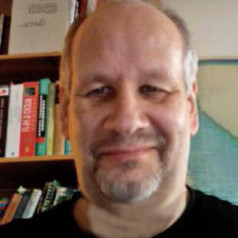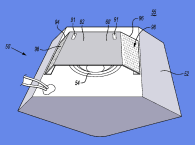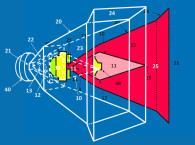
Single Enclosure Surround Sound Loudspeaker System and Method
Patent Number: US20120121092
Inventor: Bradley M. Starobin (Baltimore, MD)
Assignee: Polk Audio
Filed: November 14, 2011
US Classes: 381/17
Published/Granted: November 11, 2015
Number of Claims: 19
Number of Drawings: 24
Abstract from Patent
In at least one embodiment, a speaker system is provided. The speaker, a single-enclosure loudspeaker system, projects multichannel surround sound into a listener’s room, and so replaces multiple conventional surround channel loudspeakers. The loudspeaker system includes a pair of opposing multitransducer arrays oriented laterally toward walls or reflecting surfaces (relative to the viewing axis) within the media space. The multi-element arrays are housed in a single self-powered loudspeaker enclosure along with a single (or multiple) low-frequency electroacoustical drive element(s). In one embodiment of the invention, surround channel program material is preprocessed by an integrated wireless transmission device that performs certain digital signal processing and channel mixing steps in advance of wireless surround signal broadcast to a receiver.
Independent Claims
1. A surround sound system for audio installations, comprising: an audio surround sound source having a filter network and a wireless transmitter for transmitting filtered left and right channel surround signals; a single transducer enclosure remote from said sound source transmitter; left and right laterally spaced transducer arrays in said enclosure; and a receiver located in said enclosure to receive said left and right channel surround signals and to direct said signals to respective left and right transducer arrays to radiate said surround signals to produce a surround sound audio experience for a listener.
11. A self-contained, single enclosure surround sound system for synthesizing left and right surround effects in a listening space, comprising: an audio surround sound source having a filter network for generating filtered left and right channel surround signals; a single transducer enclosure remote from said sound source transmitter; left and right laterally spaced controlled dispersion transducer arrays in said enclosure; an amplifier in said enclosure to receive said left and right channel surround signals and to direct said signals to respective left and right controlled dispersion transducer arrays to aim and project said surround signals to produce a synthesized surround sound audio experience for a listener; wherein said single enclosure system that reproduces multiple channels of audio with a credible soundstage of sufficient breadth and spaciousness created, in part, by use of head-related transfer function (HRTF) inverse filtering, controlled directivity, or directional multi-element transducer arrays.
Reviewer Comments
In the early 1990s, to maximize envelopment and minimize source localization, LucasFilm/THX-specified dipole-based loudspeakers as the surround speakers for use in its THX-licensed home theater systems. The first patents applying these types of devices for surround sound were US Patent 5073945, “Loudspeaker System” by Satoshi Kageyama of Panasonic and US Patent 5109416, "Dipole Speaker for Producing Ambience Sound" by James J. Croft (Licensed to LucasFilm/THX).
The Kageyama system was designed for using one device for each surround channel and included various embodiments to sum the drivers to mono below a certain frequency to extend the low-frequency response. The Croft system (which I designed) was configurable to use as one device per channel or to have a single surround enclosure behind the listener that operated as a dipole summing all surround channels and creating a null on axis with the listener, generating surround sound envelopment from a single device. As often is the case, nearly a decade earlier when working at Audio Pulse, Peter Tribeman (currently the CEO at Atlantic Technology) discovered the effectiveness of using dipole loudspeaker configurations as the surround speakers with the Audio Pulse Model One delayed rear channel system.
Working with Robert Williamson in the 1990s, US Patent 5109416 was extended in a fully passive version to include a subwoofer in a single enclosure dipole surround sound unit, which could be placed behind the listener and centered against the back wall of the listening space.
Disclosed in the patent publication under review here, Bradley Starobin at Polk Audio has advanced the single enclosure, dipole surround system/subwoofer combination to a wireless, powered version of the concept. The product that was developed based on the patent application is the Polk Audio F/X Wireless Surround Sound System.
The configuration is that of a downward-firing subwoofer, which is crossed over to two pair of full-range drivers oriented upward at approximately 45° angles, aimed to the left and right. The woofer is fed a summed mono signal and crossed to the full-range drivers in the 150-to-300-Hz range.
It is suggested that the system be placed behind a sofa to further attenuate any direct sound to the listener. This would also enhance the effect of the dipole-projected surround sound arriving back at the listener only after reflecting off of at least one wall surface of the listening room. The patent application is an interesting study in system optimization to achieve various preferred effects, particularly adapting the system’s frequency response by way of pinnae and head-related transfer functions to create perceived elevation of the surround sound spatial field. The frequency-response cues set to create a similar elevation result to those now being specified by Dolby Labs in its new Atmos home theater systems.

There are many other design attributes that work together to create the preferred directivity and resulting sound field such that to a great degree it can mimic an elevated, multi-surround sound speaker system while also including a subwoofer. There are some issues that would seem to potentially compromise the effective wideband null of the left and right surround sound transducer emissions (e.g., feeding separate left and right surround sound signals to the upper range speakers instead of summing those surround sound signals into a single correlated/out of phase left/right output). The spacing of the left and right output transducers are also rather far apart to create a pure wideband null and avoid lobing in the upper frequency ranges.
All-in-all, the patent discloses what appears to be a sophisticated design of a convenient combination of a singular, powered, wireless surround sound enclosure/subwoofer hybrid. If properly optimized, the system should result in a very effective device. VC
This article was originally published in Voice Coil, January 2015.






